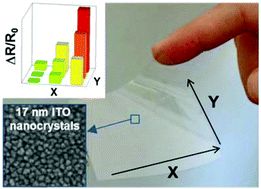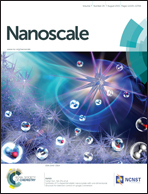A transparent flexible z-axis sensitive multi-touch panel based on colloidal ITO nanocrystals†
Abstract
Bottom-up fabrication of a flexible multi-touch panel prototype based on transparent colloidal indium tin oxide (ITO) nanocrystal (NC) films is presented. A series of 7% Sn4+ doped ITO NCs protected by oleate, octanoate and butanoate ligands are synthesized and characterized by a battery of techniques including, high resolution transmission electron microscopy, X-ray diffraction, 1H, 13C and 119Sn nuclear magnetic resonance spectroscopy, and the related diffusion ordered spectroscopy. Electrical resistivities of transparent films of these NCs assembled on flexible polyethylene terephthalate substrates by convective self-assembly from their suspension in toluene decrease with the ligand length, from 220 × 103 for oleate ITO to 13 × 103 Ω cm for butanoate ITO NC films. A highly transparent, flexible touch panel based on a matrix of strain gauges derived from the least resistive film of 17 nm butanoate ITO NCs sensitively detects the lateral position (x, y) of the touch as well as its intensity over the z-axis. Being compatible with a stylus or bare/gloved finger, a larger version of this module may be readily implemented in upcoming flexible screens, enabling navigation capabilities over all three axes, a feature highly desired by the display industry.


 Please wait while we load your content...
Please wait while we load your content...